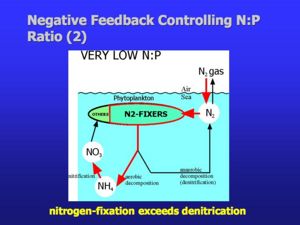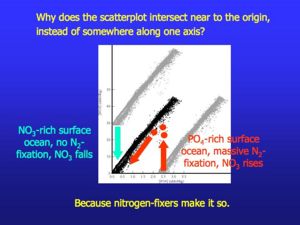Feedback on N:P Ratio
The nitrogen-phosphorus model contains the feedback on phosphate levels, but also contains a second feedback which stabilises the ocean's N:P (nitrate:phosphate) ratio. This feedback involves the ecological competition between nitrogen-fixing and non-nitrogen-fixing algae. It controls nitrate concentrations, pushing them continually towards slightly less than 16 times the phosphate concentration.
Response to low N:P ratio
When the N:P ratio in the deep oceans falls too low, water upwelling from deep contains a deficit of fixed nitrogen relative to phosphate. After blooms of diatoms and other phytoplankton remove fixed nitrogen and phosphate in a ratio of about 16:1, fixed nitrogen becomes exhausted while quantities of phosphate remain. The model contains the key assumption that these conditions are ideal for the proliferation of nitrogen-fixing phytoplankton, because only they can meet their nitrogen needs from alternative sources, because they (uniquely) are able to take up the plentiful N2. Nitrogen fixation inputs increase. Following death and decay of these organisms, the nitrogen in their cells is released initially as ammonium and then converted via nitrification to nitrate. In this way, blooms of nitrogen fixers act as conduits for the creation of new fixed nitrogen. Stimulation of nitrogen-fixer proliferation thereby indirectly raises the N:P ratio, completing the negative fedback loop.
Response to high N:P ratio
Conversely, when the N:P ratio rises too high, nitrogen-fixers become uncompetitive and nitrogen-fixation inputs decrease. The cutting off of a source of new fixed nitrogen tips the balance towards net destruction of fixed nitrogen, lowering the ratio.
Notes
The N:P ratio refers here to the ratio of fixed nitrogen (i.e. excluding N2) to phosphate.
Fixed nitrogen refers to the sum of nitrate (NO3), nitrite (NO2) and ammonium (NH4). It excludes the always plentiful N2. In deep waters fixed nitrogen is almost all made up of nitrate.
Fixed nitrogen is continually being destroyed in low oxygen environments by the processes of denitrification and anammox. The N:P ratio will rise or fall depending on whether the sum of inputs (in large part nitrogen-fixation) is greater or lesser than the sum of outputs (predominantly denitrification and anammox).



Other related pages
Nitrogen-phosphorus model overview
Nitrogen-phosphorus model details
Nitrogen-phosphorus model cons
Nitrogen-phosphorus model worksheet
References
Tyrrell, T. (1999). The relative influences of nitrogen and phosphorus on oceanic primary production. Nature 400, 525–531.